
Plague Quarantine Page Menu: 1 2 3 4 5 6 7 8 9 10 11 12 13 14 15 Next>>
Golden Age of Piracy Maritime Quarantine For Plague, Page 12
The Mediterranean Lazarettos - The Maltese Lazarettos
During the time leading up to the golden age of piracy, Malta had several locations for quarantining people. The quarantine system there began with the arrival of the Knights Hospitaller of St. John of Jerusalem in 1530. Two of the Knights were appointed to a health commission to manage the quarantine of incoming ships. "No ship was allowed to disembark passengers. crew or goods before being granted pratique by 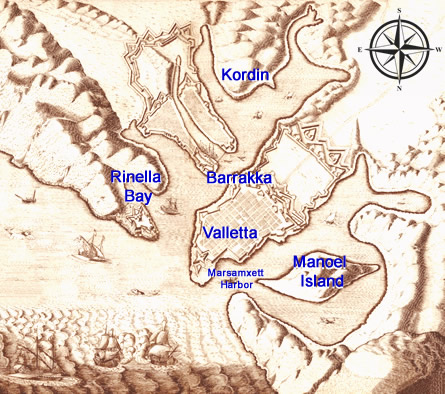
Lazaretto Locations in Malta, Shown on Map of Valletta Harbor (c. 1698)
the port sanitary authorities. Harsh punishment, including the death penalty, were meted out to anyone who infringed the regulation."1 A series of lazaretto locations were established around the Maltese capital city of Valletta before the early/mid 17th century. The first was located at the bay of the Grand Harbor at Rinella Bay. This was replaced by a second lazaretto at 'the foreshore beneath Kordin Heights'. A third was erected at Barrakka on the part of the wharf known as 'ill barria', which referred to the Italian word 'barriera', meaning a barrier, the allusion being to the railing which prevented persons undergoing quarantine from coming into contact with outsiders."2 The Barakka facility "included facilities for the accommodation of passengers and magazines for storage of luggage and provisions."3
Beginning in 1526, the part of Marsamxett Harbour which is located near Manoel Island (then called Bishop's Island) was used as a Quarantine Harbour for Malta. The Order of St. John acquired the island from the Cathedral of Mdina by trading some of the Knight's inland Maltese property in what is today Il-Wied tal-Fiddien with the intent of using it for this purpose.4 A temporary structure was built during a plague in 1592-3 which housed nine hundred patients. "A few more durable structures were also built including warehouses and a small chapel dedicated to St Roche, the saint protector of the plague-stricken."5 These structures still existed during the golden age of piracy, although they were likely demolished in the late 18th century and replaced with new warehouses in 1797.
The lazaretto which was in use during the golden age of piracy began construction on Manoel Island in 1643. Grand Master Jean Paul Lascaris of the Knights Hospitaller was appointed to oversee the building's construction. It must have been under construction for some time, because Dr. Savona-Ventura explains that the first lazaretto used on the island was 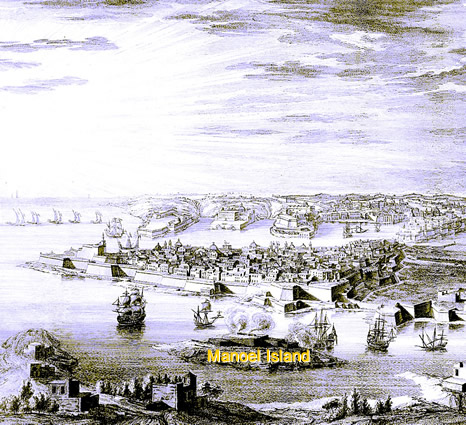
Artist: M. A. Benoist, After Joseph Goupy
View of the Quarantine Area in Malta in Front of the Lazaretto on Manoel Island, c. 1720 (1770)
"set up in 1647 [and] consisted of wooden assemblages for the disinfection of humans and animals, whilst the construction of tents provided a meagre form of shelter for the patients undergoing their quarantine"6.
Although the lazaretto building on Manoel Island appears to be a unified structure from the water, Cassar explains, "It was erected at various intervals, according to the exigencies of the times, over a stretch of three hundred years so that [only] the oldest surviving structure dates back to 1643."7 The oldest building is called Il Palazz (the palace) or Palazzo Vecchio (old palace) or Palazzo Grande (grand palace). "It consists of two floors with eight halls on each floor surrounding a large central quadrangular courtyard to which access was made through a wide portal facing the sea."8 The lazaretto was expanded and improved many times after the initial construction of that building before the end of the golden age of piracy. Such extensions occurred in 1670, 1683, and 1701. "These [last] extensions are represented by the block, to the east of Lascaris building, known as the New Palace. A series of high arches runs along the facade overlooking the sea."9 The result of all the additions occurring between 1645 and 1790 increased the size of the Manoel Island lazaretto from 86,000 square feet (8000 m2) to 323,000 square feet (30,000 m2).10
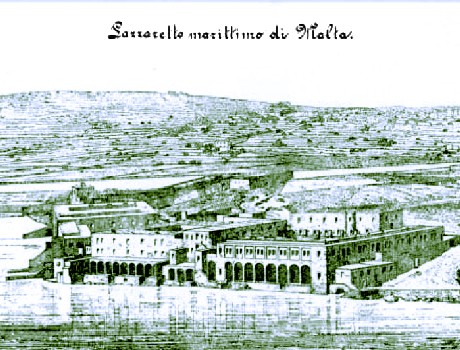
The Distinctive Arches of the Eastern Buildings of the Maltese Lazaretto on Manoel Island
From Delle Istituzzioni di Sanita Marittima Bacino del Mediterraneo (1881)
The lazaretto contains two courtyards and large warehouses with arched ceilings for goods. At the back of the first floor is a second floor which contains several small rooms where the passengers were housed. "Passengers detained in quarantine were allowed, with due precautions, to leave their apartments and spend some hours in the open air on two terraces on the first
floor."11 While quarantined In 1827, Andrew Bigelow described the lazaretto as "a vast pile of building, enclosing several squares, and capable of receiving at once ten thousand men. ...The squares are provided with inner galleries, and these are subdivided to prevent intercourse. ... There is a small quay in front of the establishment on which the recreation of walking may be enjoyed."12
Bigelow was given a two room dwelling at Manoel Island, which he describes in some detail.
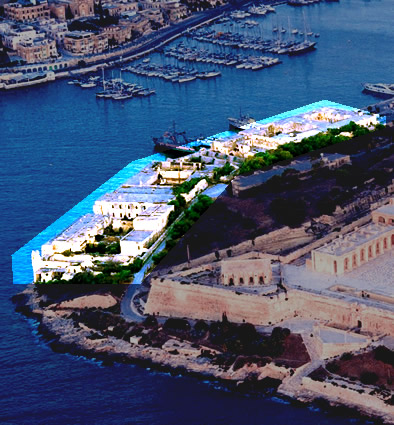
Photo: Matthew Benn - Aerial View of the Maltese Lazaretto Today (Highlighted)
The main apartment looks like a convent chapel, only dismantled of its furniture. The centre of the vaulted roof is full thirty feet from the floor. It is groined, some half score of arches meeting in the ceiling. At one end is a grated Gothic window elevated beyond reach, or hope. A large cross is painted or inlaid in the glazing. The walls are constructed of square blocks of stone, whitewashed. The floor is a flag pavement.13
As previously mentioned, several cattle sheds were added sometime after 1722 and before 1736. Rooms were built on the first floor of the cattle sheds to house the cattle's food as well as the men tending the cattle. It is not clear where this structure was located. It may have been to the left (west) of the section identified as the Old Palace in the 1881 plan shown below, a structure which was either destroyed or removed some time after the plan was drawn. (Note that identification of the areas called the Old and New Palace on this plan are based on the brief description given by Cassar.)
Cassar explains, "All the old buildings were surrounded on the landside by a triple line of high walls to prevent persons under quarantine from escaping from the lazzaretto "14. On arriving in Malta on HMS Assistance in 1675, navy chaplain Henry Teonge mentioned this systems of walls, explaining that the lazaretto "lyes closse under their outermost wall, and is extreamly neatly kept and provided for."15
 Plans of the Malta Lazzaretto, From Delle Istituzzioni di Sanita Marittima Bacino del Mediterraneo, By Giovanni Bussolin (1881) Plans of the Malta Lazzaretto, From Delle Istituzzioni di Sanita Marittima Bacino del Mediterraneo, By Giovanni Bussolin (1881)Note: The Identification of the Old and New Palace Areas is Based on Cassar's Description and May Not Be Entirely Accurate. Please Contact the Author Via the Email Link Below if You Have Better Information. Thanks. |
Two authors mention the quarantine system at Malta. The first is found George Sandys' account during a voyage he took in 1610. Although his ship "had a neat Patent [clean bill of health] to shew that those places from whence they came were free from the Infestion", it did not make landfall in Malta, leaving Sandys behind. The bill of health notwithstanding, he was required to serve quarantine. His description of the process is interesting because it occurred before the construction of the formal lazaretto on Manoel Island. After the ship departed,
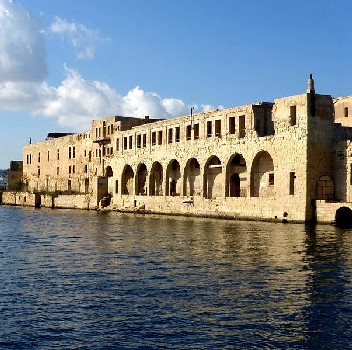
Photo: Wiki User HR58
Distinctive Arches on the Eastern Side of the Manoel Island Lazaretto
I left alone on a naked promontory right against the City; remote from the concourse of people; without provision, and not knowing how to dipose of my self. At length a little boat made towards me, rowed by an officer appointed to attend on strangers that had no Prattick [pratique], left others by comming into their company should receive the infection: who carryed me to the hollow hanging of a rock, where I was for that night to take up my łodging; and the day following to be conveyed by him unto the Lazaretta, there to remain for thirty or forty dayes before I could be admitted into the City.16
Since the Manoel lazaretto did not yet exist, Sandys must be referring to the temporary structure built at Barrakka. Sandys did not have to serve a full quarantine, however. A Maltese man with an English father petitioned on Sandys behalf and he was able to obtain pratique.
The other account of pratique comes from Henry Teonge's 1675 stop, mentioned previously. Teonge explains that they had no bill of health 'for prattick' so the ship and her crew had to "waite the governour’s leasure to have leave to com on shoare; which was detarded because our Capt. would not salute the cytty"17. Saluting the city refers to the formality of firing guns to indicate that a ship's intentions were peaceful. The captain of the Assistance seemed to think if they saluted the city, it would be taken as an aggressive act, so he anchored his ship while awaiting the outcome. "At last cam the Consull with his attendants to our ship, (but would not com on board till our Capt. had been on shoare,) to tell us that wee had leave to com on shoare 6 or 8, or 10 at a time, and might have any thing that was there to be had; with a promise to accept our salute kindly."18
The Assistance stopped at Malta twice more in January of the next year, firing friendly salutes as required. "But we have no prattick by the reason of the plague which is begun here."19 This plague, which was first recognized on Christmas Eve in 1675, raged through Malta at that time, eventually killing 11,300 people. It was suggested that it was brought to Malta by British ships, which may explain the difficulties the Assistance encountered in January.20
1 Charles Savona-Ventura, Knight Hospitaller Medicine in Malta [1530-1789], 2015, p. 46; 2 Paul Cassar, Medical History of Malta, 1964, p. 298; 3 Savona-Ventura, p. 47; 4 Paul Cassar, A Tour of the Lazzaretto Buildings (Malta), 2004, p. 369; 5 Cassar, p. 370; 6 Savona-Ventura, p. 48; 7 Cassar, A Tour..., p. 369; 8 Cassar, A Tour..., p. 370; 9 Cassar, A Tour..., p. 373; 10 Daniel Panzac, Quarantines et Lazarets, 1986, p. 37, translated by the author; 11,12 Andrew Bigelow, Travels in Malta and Sicily, 1827, p. 105; 13 Cassar, A Tour..., p. 373; 14 Cassar, A Tour..., p. 375; 15 Henry Teonge, The Diary of Henry Teonge, Chaplain on Board H.M.’s Ships Assistance, Bristol, and Royal Oak, 1675-1679, 1825, p. 48; 16 George Sandys, A relation of a journey begun an dom 1610, 1652, p. 177; 17,18 Teonge, p. 46; 19 Teonge, p. 122 - see also p. 125; 20 Noel Grima, "The 1676 plague in Malta", Malta Independant, 19 June, 2017, gathered 5/1/19
The Mediterranean Lazarettos - Marseille
Like other sites, there were several smaller lazarettos established in Marseille before a more permanent
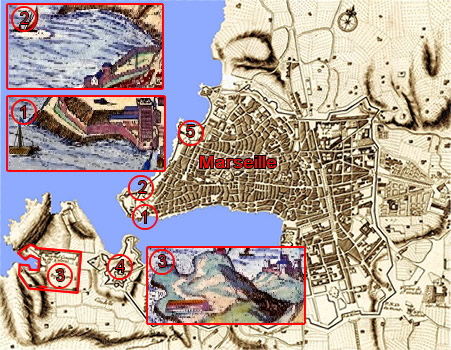
Cartographer: Nicholas de Fer - Map of Marseille Lazaretto Locations Mentioned (1702)
(Detail Images 1-3 From Map of Marseille, By Georg Braun and Franz Hogenberg (1575))
site was built. According to Professor Georges Francois, the first lazaretto in Marseilles was a mid-fifteenth century structure built on Roudeau Street, known as Notre Dame de Pitié [Our Lady of Mercy], which was located inside the city (Seen at location 1 on the image at left). "When a vessel arrived with suspicion of disease, its' cargo was confined to storage located close to the tower of St. John and the passengers were sequestered in the infirmary of the Roudeau street."1 However, after the plague struck Marseille three times between 1484 and 1506, the St. John Tower and Rondeau Street lazaretto were deemed inadequate. Another lazaretto was built close to the sea in 1527, near Ourse Cove north of the city. (location 2)"It was entrusted to the seafarers' confraternity, that of St. Barbe who was also in charge of the leproseries."2 However, plague epidemics again struck Marseille in 1527, 1530, 1547 and 1556 and the decision was made to build a bigger structure for that purpose.3 The larger lazaretto was built south of Marseille in 1557 in what was then called port Saint-Lambert. (3) "However, its distance from the city, established to the north of the port (the present-day Old Port), made it very inconvenient".4 In addition to the distance, a complaint lodged by the garrison of nearby Fort Saint-Nicolas (4), which feared the contagion, a new lazaretto was constructed.5
The lazaretto which was in use during the golden age of piracy was built between 1663 and 1668 in Saint-Martin d'Arenc north of the city called Lazaret d'Arenc (5). Within a year of the new lazaretto's completion, Jean-Baptiste Colbert (Minister of Finance and Secretary of the Navy for France) gave lazaretto d'Arenc "the monopoly of the commerce of the Levant... because it was already the main French port in the Mediterranean ...[and its' ability] to immediately satisfy the needs of the Levant trade."6
Historian Daniel Panzac explains that, with the addition of this lazaretto, the quarantine system in Marseille actually consisted of three parts, including:
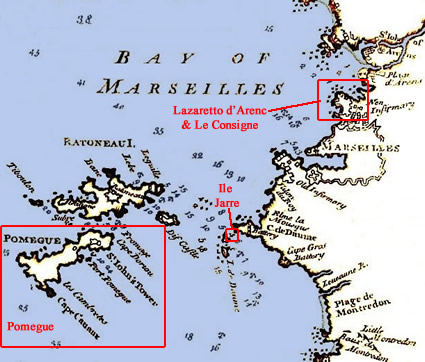
Cartographer: Henri Michelot
Marseille Lazaret d'Arenc and Pomègue Island Locations (c. 1720)
- La Consigne (The consignment office which housed the administration of the lazaretto) - "where the captains come to make their declaration on their arrival. From 1660 to 1722, it was a fixed floating pontoon at the foot of Fort Saint-Jean at the port entrance."7 A permanent building was started in 1719 which was completed in 1722, replacing the floating office.
- Le lazaret proprement (The lazaretto proper) - As built in 1668, it was "located three hundred meters north of the city, between the sea and the main road of Aix-en-Provence. In 1724, a second enclosure was built, which doubled the size of the original lazaretto."8 This was located 12 meters away from the original lazaretto.9
- L'île de Pomègues (an island off the coast of Marseille) - "a bare island and divided by coves, the largest of which, called the Grand Calanque, is located in the south, welcoming the ships in quarantine."10 The island committed about 12 acres to quarantine beginning in 1630.11 Professor Francois adds that quarantine "was appointed to the island of Jarre in cases of plague; otherwise, to the island of Pomègues"12, which suggests that those ships without confirmed plague outbreaks (having clean, suspect or foul bills of health) would serve quarantine at Pomègues as Panzac says.
John Howard describes the site of the lazaretto, explaining that it "is on an elevated rock near the city, at the end of the bay, fronting the south-west, and commands the entrance of the harbour. It is very spacious, and its situation renders it very commodious for the great trade
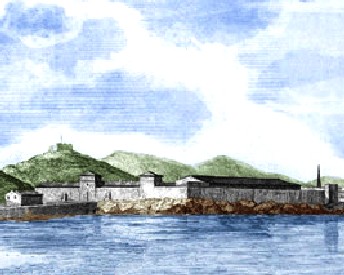
Marseille's Lazaret d'Arenc (1848)
which the French carry on in the Levant."13 The original Lazaretto d'Arenc contained two sections: the Grand Enclos (Big Enclosure) and the Petit Enclos (Small Enclosure), the outlines of which are found in the lazaretto plan from John Howard's 1789 edition of his An Account of the Principal Lazarettos in Europe (seen below). The Big Enclosure was reserved for people and goods arriving on ships with clean bills of health while the Small Enclosure was used for those who did not come on ships with clean bills.14
As mentioned, the lazaretto was expanded near the end of the golden age of piracy with the addition of the New Infirmary in 1724. Including this structure, Panzac notes that the perimeter of the structure measured 2,923 meters [9500 feet] "with a 179 meter [587 foot] side between the cove of Joliette and the tip of Arenc. It occupied an area of 17.8 hectares [44 acres] divided into seven enclosures separated by walls."15 It is not entirely clear from Howard's 1789 diagram how big the two original sections - the Big and Small Enclosures - actually were before the additions were made. Nor is it clear if the Leather Purging are seen at the far left side of the plan was added in 1724 or later.
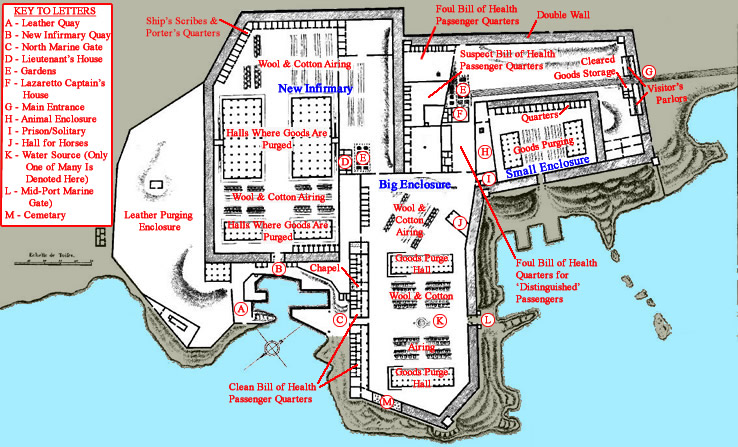 Plans of the Lazaret d'Arenc, From An Account of the Principal Lazarettos in Europe, By John Howard, (1789) Plans of the Lazaret d'Arenc, From An Account of the Principal Lazarettos in Europe, By John Howard, (1789) |
In addition to the above plan, there are two descriptions of the Marseille lazaretto. Unfortunately, the earliest, comes from Howard's 1789 book, sixty-four years after the end of the golden age of piracy. The second description is even later, given in a travel guide published by Armand Pignel in 1836. Being the only two historical descriptions discovered, these will be used here with the understanding that both describe the lazaretto well after the period of interest and after the 1724 additions were completed.
Pignel notes that the lazaretto was within range of Marseille's cannon, which would have been important to protecting both the site and those serving quarantine.
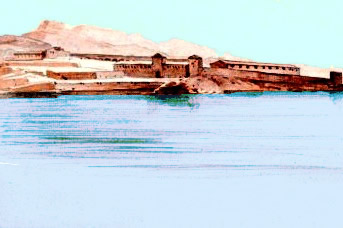
Lazaret d'Arenc (19th Century)
It had three main gates, two overlooking the landing-place (B & C in the above diagram), and one on the path leading to Aix (G).Of the main door leading to Aix, he explains that it "is the one through which one leaves the lazaretto: on the right and on the left of this door is a covered gallery, about sixty feet long and which serves as a parlor for people in quarantine that friends or acquaintances visit."16
Pignel also mentions the "immense warehouses to bring the goods and objects into quarantine. Then, between these warehouses, drying places where quarantine bales are placed on benches."17 The scattered nature of the covered warehouses and uncovered drying benches can be seen in the diagram. It is curious that the benches, which are specified to be for drying wool and cotton, were not covered. Pignel says, "It seems that cotton can stay in the rain without being damaged."18
Several authors note that the people who ran the lazaretto lived inside of it.19 (See D & F on the above diagram for examples.) Daniel Panzac notes that the captain of the lazaretto's 'apartment' is isolated, being "located so as to be able to monitor the whole of the Establishment places under his responsibility."20 He also notes that it has its own garden (E). The plan shows that the lieutenant's house had a garden as well. Although not shown on the plan, Pignel explains that there are "a large number of employees, such as guards, porters and workmen who live in small houses scattered in the various parts of its enclosure."21 All three authors also mention the chapel (denoted on the diagram) where Howard says "divine service is regularly performed"22.
Details of the water sources are discussed on the diagram Howard includes in his book. Although only one is denoted on this copy of the plan for clarity (K), there are actually fourteen others indicated on the map in Howard's book. There are two at entrances B & L, on the quay near C and the unmarked entrance at the bottom of the Small Enclosure between the double walls. The other seven are either located inside the Big and Small Enclosures, usually indicated by a solid round dot on the plan. Curiously, there are no water sources indicated inside the New Enclosure.
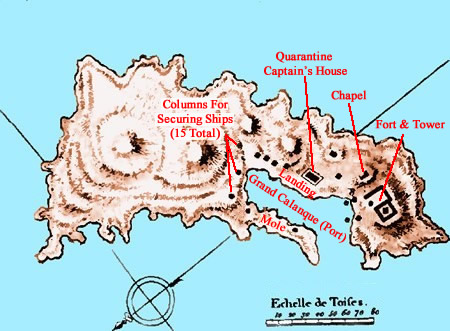
Plan of L'île de Pomègues, From An Account of the Principal Lazarettos in Europe,
By John Howard, (1789)
The other location active for quarantine during the golden age of piracy was the island of Pomègues, where ships were sent when the crew was serving quarantine aboard. As mentioned, its use pre-dated the construction of the Lazaret d'Arenc by thirty years. The cove where the ships docked was not entirely natural. Panzac explains that a mole (or barrier) was built to create the Grand Calanque cove. "With the addition of a small mole, it could shelter as well as quarantine as many as forty ships of 200 to 300 tons when arranged in two ranks."23 The map which Howard includes in his book (seen at left) has a key which explains that the mole was built by connecting a little isle now located at the end of it to Pomègues which is how the harbor was created.
Panzac also notes that there is a house for the captain and an 'open chapel' on the island. The map key in Howard's book says that masses performed there were "in sight of the ships which are in the Port."24 This is why it is important that the chapel was 'open'. That way, the sailors on ships in quarantine could remain aboard and still see the mass while it was being performed without coming into contact with others and violating the rules of quarantine. Howard's map key mentions another interesting detail: the fifteen columns identified on the island (shown as black dots or squares on the map) which were "dug into the rock of the mountain to fasten the Ships."25
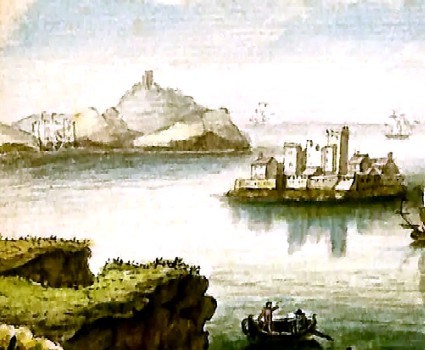
L'îles de Pomègues [right] and If [left] (c. 1772-7)
Note the Fort on Top of the Hill and the Sails in the Harbor on the Left of Pomègues.
(Île d'If was was clearly inhabited at this time and not not used for quarantine.)
In the 1716 rules for quarantine at Marseille, there are several which offers insight into how things worked on the island. No vessels were allowed to enter the port "without an express written order from a Quartermaster"26. In addition, ships were not allowed to land goods on the island at night. Where the goods were placed for quarantine on the island isn't clear. There do not appear to have been any warehouses or other structures for this purpose, so presumably only goods that could be outside were landed on Pomègues. Captains and crews were required to serve quarantine on their ships at Pomègues while passengers had to report to the lazaretto.27
English sailor Edward Barlow mentions the quarantine process at Marseille when he was there aboard third rate HMS Monke in 1675. He says, "we came amongst the small islands that lie before Marseilles, and in the morning we came to an anchor before the town. And sending our boat on shore, we had ‘pratique’, and our merchant Mr. Hill, ordered us to come into the harbour, for we had had a long passage from Tangier of thirty-two days."28 It is interesting that they were so readily given pratique, given that the 1716 rules state that passengers on ships with clean bills of health were supposed to serve eight days of quarantine.29 It is possible these rules were not in effect in 1675, perhaps being set after plague outbreaks in Marseille in 1691 and 1710.30 There may also have been special considerations for ships of her majesty's fleet; 1675 was a rare time of peace between France and England.
1 Georges Francois, "Les lazarets de Marseille", Association des Amis du Patrimoine Medical de Marseille, gathered 4-25-19, translated by the author; 2 See Francois, "Les lazarets de Marseille", & Daniel Panzac, Quarantines et Lazarets, 1986, p. 180, translated by the author; 3 See Francois, "Les lazarets de Marseille" & Rémi Barbieri & Michel Drancourt, "Two thousand years of epidemics in Marseille and the Mediterranean Basin", New Microbes and New Infections, November 2018, p. S4; 4 Panzac, p. 180; 5 Francois, "Les lazarets de Marseille" & Panzac, p. 180; 6 Panzac, p. 34-5; 7,8,9 Panzac, p. 181; 10 Francois, "Les lazarets de Marseille"; 11 Panzac, p. 38; 12 Francois, "Les lazarets de Marseille"; 13 John Howard, An Account of the Principal Lazarettos In Europe, 1791, p. 3-4 14 “Lazaret d'Arenc”, fr.wikipedia.org, gathered 5/24/19, translated by the author; 15 Panzac, p. 181; 16 Armand Pignel, Conducteur ou guide du voyageur et du colon de Paris a Alger et dans L’Algerie, Avec Carte Itineraire, 1836, p. 221, translated by the author; 17,18 Pignel, p. 220; 19 Panzac, p. 26, Pignel, p. 220 & Howard, p. 4; 20 Panzac, p. 26, 21 Pignel, p. 220; 22 Howard, p. 4; 23 Panzac, p. 181; 24 Howard, Map of Marseille, Plate 1, Opposite p. 2, translated by the author; 25 Howard, Map of Marseille, Plate 1, Opposite p. 4, translated by the author with help from Brian Chabot, Mattieu Lavoie, Marc Lauterbach & Noah Aton; 26 Panzac, p. 132; 27 Panzac, p. 133; 28 Edward Barlow, Barlow’s Journal of his Life at Sea in King’s Ships, East and West Indiamen & Other Merchantman From 1659 to 1703, p. 271; 29 Panzac, p. 136; 28 Panzac, p. 188

